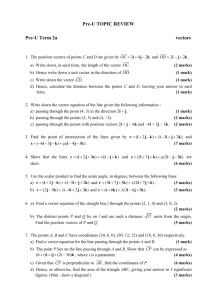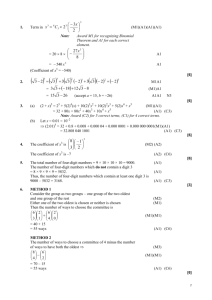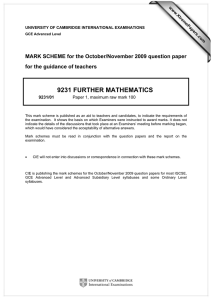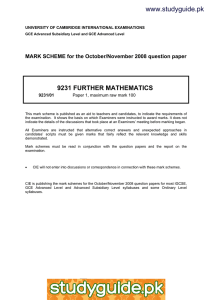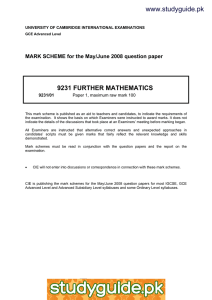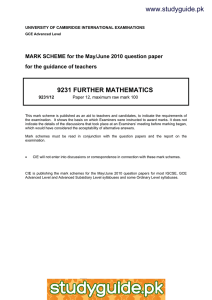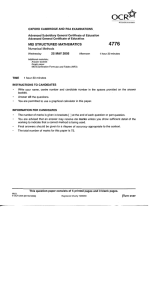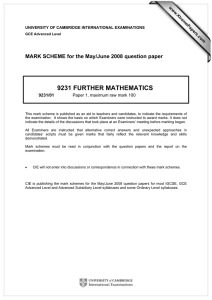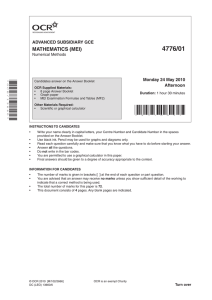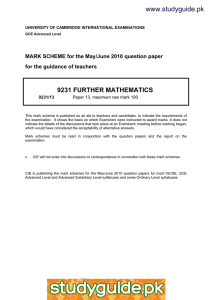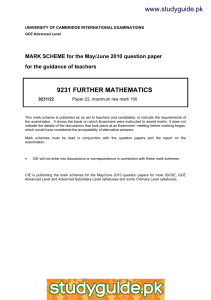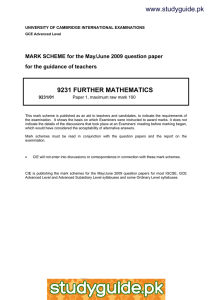www.studyguide.pk 9231 FURTHER MATHEMATICS
advertisement
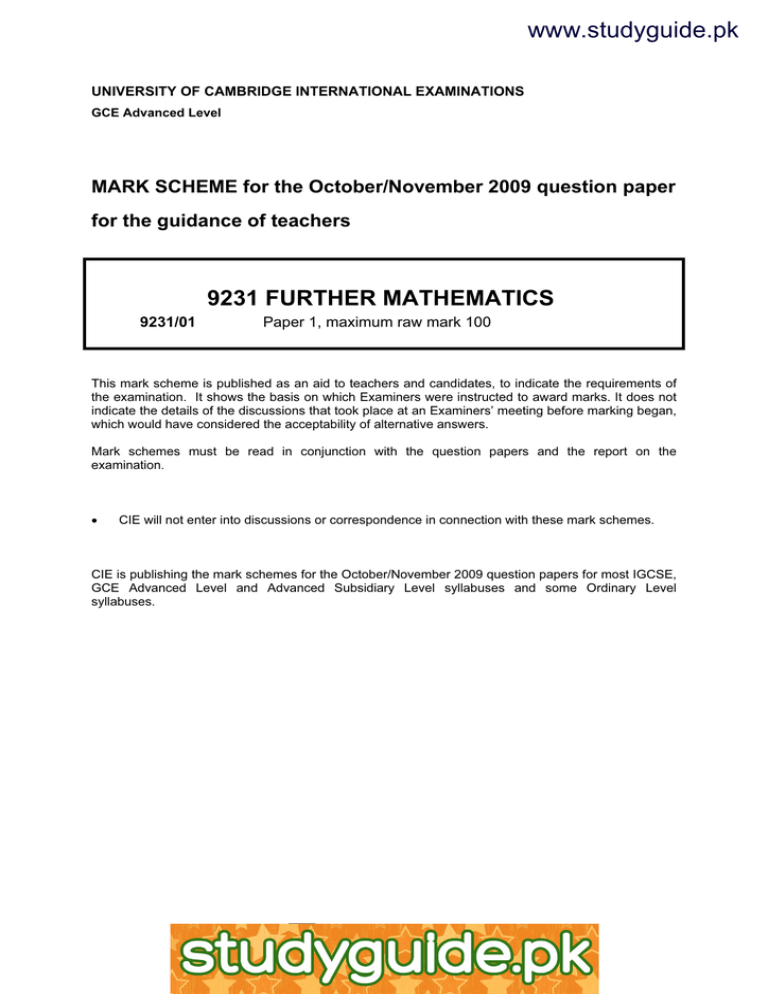
www.studyguide.pk UNIVERSITY OF CAMBRIDGE INTERNATIONAL EXAMINATIONS GCE Advanced Level MARK SCHEME for the October/November 2009 question paper for the guidance of teachers 9231 FURTHER MATHEMATICS 9231/01 Paper 1, maximum raw mark 100 This mark scheme is published as an aid to teachers and candidates, to indicate the requirements of the examination. It shows the basis on which Examiners were instructed to award marks. It does not indicate the details of the discussions that took place at an Examiners’ meeting before marking began, which would have considered the acceptability of alternative answers. Mark schemes must be read in conjunction with the question papers and the report on the examination. • CIE will not enter into discussions or correspondence in connection with these mark schemes. CIE is publishing the mark schemes for the October/November 2009 question papers for most IGCSE, GCE Advanced Level and Advanced Subsidiary Level syllabuses and some Ordinary Level syllabuses. www.xtremepapers.net www.studyguide.pk Page 2 Mark Scheme: Teachers’ version GCE A LEVEL – October/November 2009 Syllabus 9231 Paper 01 Mark Scheme Notes Marks are of the following three types: M Method mark, awarded for a valid method applied to the problem. Method marks are not lost for numerical errors, algebraic slips or errors in units. However, it is not usually sufficient for a candidate just to indicate an intention of using some method or just to quote a formula; the formula or idea must be applied to the specific problem in hand, e.g. by substituting the relevant quantities into the formula. Correct application of a formula without the formula being quoted obviously earns the M mark and in some cases an M mark can be implied from a correct answer. A Accuracy mark, awarded for a correct answer or intermediate step correctly obtained. Accuracy marks cannot be given unless the associated method mark is earned (or implied). B Mark for a correct result or statement independent of method marks. • When a part of a question has two or more “method” steps, the M marks are generally independent unless the scheme specifically says otherwise; and similarly when there are several B marks allocated. The notation DM or DB (or dep*) is used to indicate that a particular M or B mark is dependent on an earlier M or B (asterisked) mark in the scheme. When two or more steps are run together by the candidate, the earlier marks are implied and full credit is given. • The symbol √ implies that the A or B mark indicated is allowed for work correctly following on from previously incorrect results. Otherwise, A or B marks are given for correct work only. A and B marks are not given for fortuitously “correct” answers or results obtained from incorrect working. • Note: B2 or A2 means that the candidate can earn 2 or 0. B2/1/0 means that the candidate can earn anything from 0 to 2. The marks indicated in the scheme may not be subdivided. If there is genuine doubt whether a candidate has earned a mark, allow the candidate the benefit of the doubt. Unless otherwise indicated, marks once gained cannot subsequently be lost, e.g. wrong working following a correct form of answer is ignored. • Wrong or missing units in an answer should not lead to the loss of a mark unless the scheme specifically indicates otherwise. • For a numerical answer, allow the A or B mark if a value is obtained which is correct to 3 s.f., or which would be correct to 3 s.f. if rounded (1 d.p. in the case of an angle). As stated above, an A or B mark is not given if a correct numerical answer arises fortuitously from incorrect working. For Mechanics questions, allow A or B marks for correct answers which arise from taking g equal to 9.8 or 9.81 instead of 10. © UCLES 2009 www.xtremepapers.net www.studyguide.pk Page 3 Mark Scheme: Teachers’ version GCE A LEVEL – October/November 2009 Syllabus 9231 Paper 01 The following abbreviations may be used in a mark scheme or used on the scripts: AEF Any Equivalent Form (of answer is equally acceptable) AG Answer Given on the question paper (so extra checking is needed to ensure that the detailed working leading to the result is valid) BOD Benefit of Doubt (allowed when the validity of a solution may not be absolutely clear) CAO Correct Answer Only (emphasising that no “follow through” from a previous error is allowed) CWO Correct Working Only – often written by a ‘fortuitous' answer ISW Ignore Subsequent Working MR Misread PA Premature Approximation (resulting in basically correct work that is insufficiently accurate) SOS See Other Solution (the candidate makes a better attempt at the same question) SR Special Ruling (detailing the mark to be given for a specific wrong solution, or a case where some standard marking practice is to be varied in the light of a particular circumstance) Penalties MR –1 A penalty of MR –1 is deducted from A or B marks when the data of a question or part question are genuinely misread and the object and difficulty of the question remain unaltered. In this case all A and B marks then become “follow through √” marks. MR is not applied when the candidate misreads his own figures – this is regarded as an error in accuracy. An MR–2 penalty may be applied in particular cases if agreed at the coordination meeting. PA –1 This is deducted from A or B marks in the case of premature approximation. The PA –1 penalty is usually discussed at the meeting. © UCLES 2009 www.xtremepapers.net www.studyguide.pk Page 4 1 Mark Scheme: Teachers’ version GCE A LEVEL – October/November 2009 Syllabus 9231 (i) MV of y1 over 0 Y x Y π/2 = 2/π [x2 sinx] π0 / 2 = ... = π/2 (AG, CWO) 2 (ii) MV of y2 over 0 Y x Y π/2 = 2/π [2x sinx + x2 cosx] π0 / 2 = 2 M1A1 Evaluates some relevant vector product, e.g., (i – j – k) × (i + j + θk) = (1 – θ)i – (1 + θ)j + 2k M1A1 p = [(1 − θ )i − (1 + θ ) j + 2k ]. i / 2θ + 6 M1 = (1 − θ )/ 2θ 2 + 6 A1 Puts p = 1 / 2 to obtain a horizontal equation such as 2θ2 + 6 = 2(θ – 1)2 ⇒ … ⇒ θ = –1 M1 A1 (i) (1,0), (4,0) (0,4) B1 B1 (ii) One asymptote is x = –1 y = x – 6 + 10/(x + 1) Other asymptote: y = x – 6 B1 M1 A1 (iii) Sketch: Axes and asymptotes Upper branch: Correct location and orientation Lower branch correctly located and orientated 4 5 M1 A1 2 3 Paper 01 B1 B1 B1 dx/dt = 1 + cost, dy/dt = 2t – 2sint dy/dx = (2t – 2sint)/(1 + cost) Any correct result for d(dy/dx)/dt in terms of t d2y/dx2 = [(2 – 2cost)(1 + cost) + sint(2t – 2sint)]/(l + cost)3 (AEF) d2y/dx2 = 2tsint/(l + cost)3 (AG) Consideration of sign of d2y/dx2 –π < t < 0: (–)(–)/+ > 0; 0 < t < π : (+)(+)/+ > 0 ⇒ d2y/dx2 > 0, ∀ non-zero t ∈ (–π,π) M1A1 B1 M1A1 A1 M1 A1 Shows y = –3/x ⇒ y3 – 5y2 – 9 = 0 y = –3/x ⇒ y = αβγ/x ⇒ y = βγ, γα, αβ when x = α, β, γ, respectively B1 M1 M1A1 OR for previous 3 marks: βγ + γα + αβ = 5 α2βγ + αβ2γ + αβγ2 = αβγ(α + β + γ) = αβγ × 0 = 0 βγγααβ = (αβγ)2 = 9 Σα2β2 = 25 – (2 × 0) = 25 Σα3β3 – 5 Σα2β2 – 27 = 0 ⇒ … ⇒ Σα3β3 = 152 B1 B1 B1 M1A1 M1A1 A1 © UCLES 2009 www.xtremepapers.net www.studyguide.pk Page 5 6 [x dx d n −1 Mark Scheme: Teachers’ version GCE A LEVEL – October/November 2009 ] 4 − x 2 = (n − 1)x n−2 4 − x 2 − x n / 4 − x 2 Shows that this preliminary result implies first displayed result (AG) [x ] 1 4 − x 2 0 = 4(n − 1)I n− 2 − nI n ⇒ … ⇒ second displayed result (AG) n −1 B1 M1A1 M1 A1 B1B1 I4 = π − 7 3 / 4 M1A1 OR for last 4 rnarks: 2 I 2 = 4.1.π / 6 − 3 M1 ⇒ I2 = π / 3 − 3 / 2 A1 ) ⇒ 4 I 4 = 4 .3 π / 3 − 3 / 2 − 3 A1 ⇒ I4 = π − 7 3 / 4 A1 ( 64 sin 6 θ = −( z − 1 / z ) z = e iθ 6 ( 6 ) + 6(z 6 = − z + 1/ z 4 + 1/ z ) ) − 15(z 4 2 + 1/ z 2 ) + 20 sin 6 θ = 5 / 16 − (15 / 32 ) cos 2θ + (3 / 16 ) cos 4θ − (1 / 32 ) cos 6θ sin 2 x = 5 / 16 − (15 / 32 ) cos 4 x + (3 / 16 ) cos 8 x − (1 / 32 ) cos12 x 6 Any one of ∫ π/4 0 coskx dx = 0 for k = 1, 2, 3 M1 M1A1 M1A1 M1 B1 Further B1 if all 3 are written down or implied B1 ∫ A1 π/4 0 6 sin 2 x dx = 5π/64 or πa / 4 (CWO) OR for last 4 marks I = (1/2)∫ π/2 0 sin 6 u du = (1/64 )∫ π/2 (10 − 15cos2u + 6cos4u − cos6u ) du π/2 = (1 / 64 )[10u − 15 sin 2u / 2 + 3 sin 4u / 2 − sin 6u / 6] 0 0 = 5π / 64 (CWO) 8 Paper 01 I 0 = π / 6 ⇒ I 2 = π / 3 − 3 / 2, 4 I 4 = 12 I 2 − 3 , (all) ( 7 Syllabus 9231 M1 M1A1 A1 (a) y = tanx B1 2 1 M1 1 + y = sec x s=∫ π/3 0 sec x dx (AEF) ( ) M1A1 dx (AEF) M1A1 = [ln (sec x + tan x )] 0 = ... = ln 2 + 3 (AG) (b) S = 4π π/3 1/ 2 1 ∫ (x + 3) (1 + 1 / (x + 3)) 1/ 2 0 1/ 2 1 = ... = 4π ∫ (x + 4 ) dx 0 [ = (8π / 3)[5 A1 A1 ] 3/ 2 1 0 A1 5 − 8 (AG) A1 = (8π / 3)(x + 4) ] © UCLES 2009 www.xtremepapers.net www.studyguide.pk Page 6 9 x dy = Mark Scheme: Teachers’ version GCE A LEVEL – October/November 2009 dy dx du Some relevant, correct intermediate result such as: x 2 d 2 y / dx 2 + x(dy / dx ) = d 2 y / du 2 ( ⇒ x2 ) 2 d y dx 2 = 2 d y du 2 − dy du (AG) A1 2 M1 0 π/3 A1 0 = ... = πa 2 / 12 (AG) A1 (ii) Considers y = a sin 3θ sin θ dy / dθ = 0 ⇒ 3 cos 3θ sin θ + sin 3θ cos θ = 0 ⇒ ... ⇒ tan 3θ + 3 tan θ = 0 (AG) ( M1A1 M1A1 M1A1 ( )∫ sin 3θ dθ = (a / 4 )∫ (1 − cos 6θ ) dθ 2 B1 M1A1 y = A / x + B / x3 + 2x 2 π/3 Paper 01 A1 Uses x = e u to obtain: d2y dy +4 + 3 y = 30e 2u (AG) 2 du du Complementary function = Ae − u + Be −3u Particular integral = 2e 2u General solution for y in the x-domain: 10 (i) Area = a 2 / 2 Syllabus 9231 )( ) (iii) Uses tan 3θ = 3 tan θ − tan 3 θ / 1 − 3 tan 2 θ to obtain tan 2 θ = 3 / 5 Uses y = sin 3θ sin θ with tan θ = 3 / 5 Obtains y = 9a/16 (Accept 0.5625a, or 0.563a) (iv) Closed loop entirely in the first quadrant with lower end at the pole and clearly tangential to the initial line at the pole Symmetric about line θ = π / 6 with correct shape at (a, π /6) © UCLES 2009 www.xtremepapers.net B1 M1 A1 M1A1 M1 A1 B1 B1 www.studyguide.pk Page 7 Mark Scheme: Teachers’ version GCE A LEVEL – October/November 2009 11 EITHER Syllabus 9231 H k : S k = ∑ n =1 n3 = (1 / 4 )k 2 (k + 1) for some k k 2 B1 H k ⇒ S k +1 = (1 / 4 )k 2 (k + 1) + (k + 1) 2 3 M1 = ... = (1 / 4)(k + 1) (k + 2) so that H k ⇒ H k +1 2 2 M1A1 A1 Verifies H1 is true and completes induction argument ∑ (20n N n =1 3 ) + 36n 2 = 5 N 2 ( N + 1) + 6 N ( N + 1)(2 N + 1) 2 M1 = ... = N ( N + 1)( N + 3)(5 N + 2) (AG) S N = N ( N + 1)( N + 3)(5 N + 2) + (µ / 2)N ( N + 1) ( M1A1 M1 ) = N ( N + 1) 5 N + 17 N + 6 + µ / 2 Take µ = −12 , then S N = N 2 ( N + 1)(5 N + 17 ) so that a = 5, b = 17 2 Paper 01 M1 A1 N −4 S N = 5 + 22 / N + 17 / N 2 , > 5 + 22 / N , ∀N [=1 M1, A1 2 N [=18 ⇒ N > 17 ⇒ 17 / N < 1 / N ⇒ N −4 S N < 5 + 23 / N (AG) A1 11 OR det (A + 2I) = ... = 2a + 16 det (A + 2I) = 0 ⇒ a = –8 M1A1 A1 2 Eigenvectors corresponding to –2 and –5: any non-zero scaling of 3 , 1 1 0 −1 M1A1A1 (i) x ∈ V ⇒ x of the form pe1 + qe2 Ax = A(pe1 + qe2) = p(Ae1) + q(Ae2) = –2pe1 – 5qe2 ∈ V B1 M1A1 A1 (ii) (2i + 3j + k) × (i – k) = –3i + 3j – 3k (AEF) A(i – j + k) = 11i + 8j – 15k which is not a scaling of i – j + k Hence i – j + k is not an eigenvector of A (CWO) M1A1 M1 A1 OR for the last 2 marks 4 3rd eigenvector is –4 with corresponding eigenvector − 1 − 4 ∴ i – j + k is not an eigenvector © UCLES 2009 www.xtremepapers.net B1 B1
